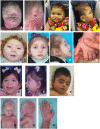Cohesin complex-associated holoprosencephaly
- PMID: 31334757
- PMCID: PMC7245359
- DOI: 10.1093/brain/awz210
Cohesin complex-associated holoprosencephaly
Abstract
Marked by incomplete division of the embryonic forebrain, holoprosencephaly is one of the most common human developmental disorders. Despite decades of phenotype-driven research, 80-90% of aneuploidy-negative holoprosencephaly individuals with a probable genetic aetiology do not have a genetic diagnosis. Here we report holoprosencephaly associated with variants in the two X-linked cohesin complex genes, STAG2 and SMC1A, with loss-of-function variants in 10 individuals and a missense variant in one. Additionally, we report four individuals with variants in the cohesin complex genes that are not X-linked, SMC3 and RAD21. Using whole mount in situ hybridization, we show that STAG2 and SMC1A are expressed in the prosencephalic neural folds during primary neurulation in the mouse, consistent with forebrain morphogenesis and holoprosencephaly pathogenesis. Finally, we found that shRNA knockdown of STAG2 and SMC1A causes aberrant expression of HPE-associated genes ZIC2, GLI2, SMAD3 and FGFR1 in human neural stem cells. These findings show the cohesin complex as an important regulator of median forebrain development and X-linked inheritance patterns in holoprosencephaly.
Keywords: X-linked inheritance; cohesin complex; forebrain division; holoprosencephaly.
Published by Oxford University Press on behalf of the Guarantors of Brain 2019. This work is written by US Government employees and is in the public domain in the US.
Figures


Comment in
-
Another case of holoprosencephaly associated with RAD21 loss-of-function variant.Brain. 2020 Aug 1;143(8):e64. doi: 10.1093/brain/awaa173. Brain. 2020. PMID: 32696056 No abstract available.
-
Reply: Another case of holoprosencephaly associated with RAD21 loss-of-function variant.Brain. 2020 Aug 1;143(8):e65. doi: 10.1093/brain/awaa177. Brain. 2020. PMID: 32712652 Free PMC article. No abstract available.
References
-
- Aoi H, Lei M, Mizuguchi T, Nishioka N, Goto T, Miyama S et al. . Nonsense variants in STAG2 result in distinct sex-dependent phenotypes. J Hum Genet 2019; 64: 487–92. - PubMed
-
- Boyle MI, Jespersgaard C, Brondum-Nielsen K, Bisgaard AM, Tumer Z. Cornelia de Lange syndrome. Clin Genet 2015; 88: 1–12. - PubMed
-
- Boyle MI, Jespersgaard C, Nazaryan L, Bisgaard AM, Tumer Z. A novel RAD21 variant associated with intrafamilial phenotypic variation in Cornelia de Lange syndrome: review of the literature. Clin Genet 2017; 91: 647–9. - PubMed
Publication types
MeSH terms
Substances
Grants and funding
LinkOut - more resources
Full Text Sources
Molecular Biology Databases
Miscellaneous

